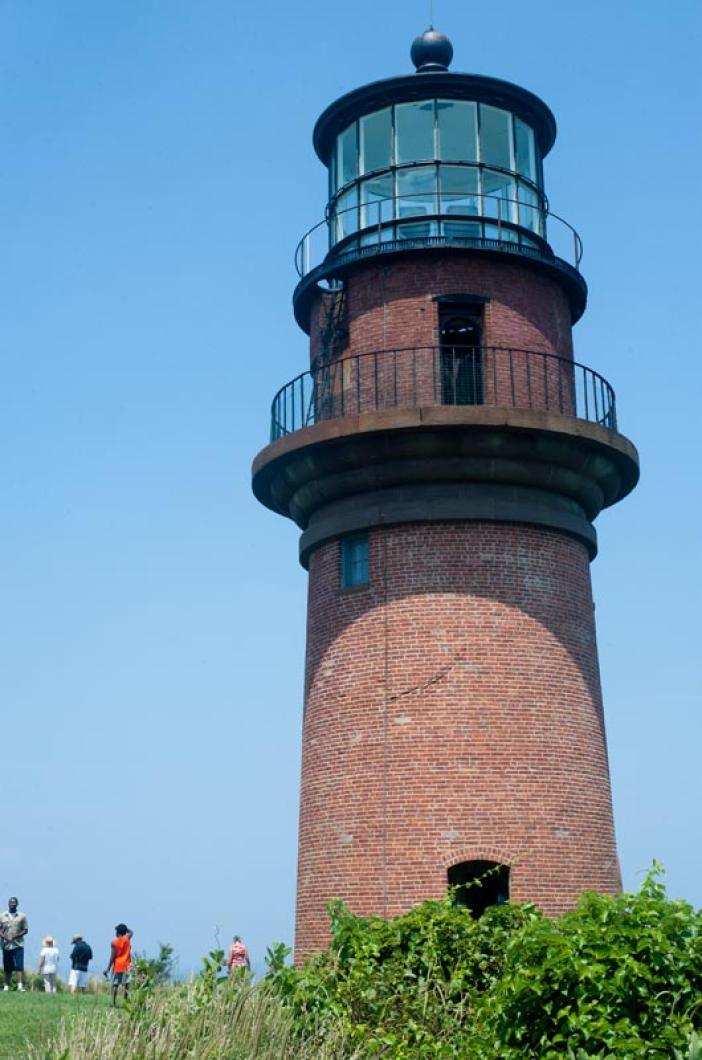The federal government formally declared the Gay Head Light surplus property Thursday, clearing the way for the town of Aquinnah to take ownership of the lighthouse which is now critically endangered due to erosion.
The General Services Administration posted the notice Thursday, making the lighthouse surplus property. Aquinnah voters have already agreed that the town will apply to take ownership of the historic brick tower. The Coast Guard currently owns the lighthouse, which is managed by the Martha’s Vineyard Museum.
“We’re certainly happy the GSA has announced that we can now apply, and we certainly will,” said Aquinnah selectman Beverly Wright.
The news from the GSA comes as a town and Islandwide public and private effort kicks into high gear to save the lighthouse, which sits just 47 feet from the edge of the rapidly eroding Gay Head Cliffs.
Geological studies are under way to determine more precisely how much more land may be lost to storms this winter, amid ongoing efforts to raise an estimated $3 million needed to move the lighthouse. International Chimney Co., the Buffalo, N.Y., firm that has moved both the Cape Hatteras Light in North Carolina and the Sankaty Light on Nantucket, has said it can relocate the light, but at least 30 feet is needed around the tower to accomplish the move.
The move is currently planned for the fall of 2014.
Fundraising efforts have begun in Aquinnah and across the Island, along with an awareness campaign about the lighthouse and its history, which dates to 1799 when the first wood-frame tower was built. The present brick tower dates to 1856.
A 10K road race is planned for early October. Some town money has been pledged from its Community Preservation Act fund. A website (savethegayheadlight.org) has been created.
Meanwhile, geology studies at the Cliffs have attracted the attention of the U.S. Geological Survey. Byron Stone, a research geologist specializing in glacial stratigraphy of the eastern United States, is embarking on a statewide glacial mapping project to create surficial maps of the area. Mr. Stone and his team are paying close attention to activity at the Gay Head Cliffs. “This is a world-class geological exposure,” he said. “People from all over the world . . . read about this. It’s one of the best examples and best exposed examples of glacial tectonics.”
The cliffs formed from the glacier moving bedrock and “thrusting them up like a stack of cards,” he explained.
“It’s hard to see exposure like that in, say, North Dakota or Alberta,” Mr. Stone said. “This is one of the few places in the world . . . where you can actually go and take pictures and study the nature of the formation. It’s a very, very exciting place.”
He continued: “It’s hallowed ground for the Wampanoags and it’s hallowed ground for geologists. It’s that good.”
Preliminary work done by geologist Patrick Williams indicates that a trapped water table in the clay cliffs may be accelerating erosion. Although still at an early stage and not yet approved, a plan has been proposed to drill a well through the Cliffs to release the trapped water and slow the erosion by creating more stability.
Mr. Stone’s work will help analyze a new site location and best travel route.
“With a little more field work and reference to previous data, we can be assured that the geology we see at the Cliffs where the clay is and where the sand is indicates that is probably what is under the land,” he said. “You want to make sure you site a lighthouse on sand, which is a material that can hold . . . that weight.”
A town committee is exploring options for a site to relocate the lighthouse. One site under consideration is a town-owned piece of property near the shops at the Cliffs.
Committee chairman Len Butler said George Sourati, a Vineyard Haven engineer, will visit the Cliffs next week to survey erosion rates from the past year. Markers were placed around the lighthouse area a year ago as part of a three-year study to measure the eroding bluff. Initial findings should be available in two weeks, Mr. Butler said. Mr. Stone will help analyze the data.
“Last winter was a pretty severe winter in terms of erosion,” the geologist said.
The committee plans to issue a request for proposals at the end of the month for a geotechnical study to collect data on subsoil conditions for possible site locations and travel routes, to ensure the land can support the weight of the move. It is estimated that the lighthouse weighs 400 tons.
“In terms of lighthouses, it’s a lightweight,” Mr. Butler said.
Work on that study is expected to be done in October. Mr. Butler said they hope to select a new site over the winter.
But the project to move the lighthouse is rapidly running short on time.
“There was a big slide recently on the western face of the cliff,” Mr. Butler said. He said the landslide caused a large boulder of gray clay to come crashing down. “That was a warning bell.”
For more information on the lighthouse project, go to savethegayheadlight.org.







Comments
Comment policy »